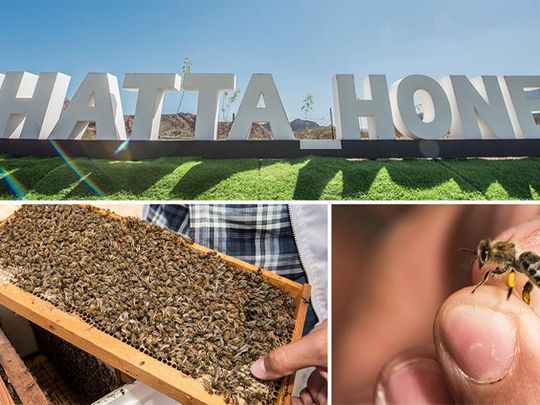
‘They don’t sting at all, unless provoked.’ Try telling that to a group consisting of an 11-year-old girl who despite her fear of all things that fly or crawl is putting on a brave front today, and a few nervous-looking adults — one of whom painfully remembers the sting he endured as a child and is therefore in a rush to cover every possible inch of his jean-clad body with a protective suit. Despite our beekeeper’s assurances that the bees in his garden are ‘friendly’, we are not prepared to take any chances, and so we don the protective jacket with a ventilated covering for our faces, and slip our hands into long-sleeved gloves, ensuring that no skin is visible anywhere.
It is a cold and crisp morning, and we are at the Hatta Honey Bee Garden to undertake a journey of discovery — to experience the wonder of honey-making in action, and to learn how hundreds of thousands of tiny creatures labour day and night performing a task that enables us to have food on our plates.
We had left Dubai shortly before 9am where it was bright and sunny to set out on a good 135km to our destination, Hatta. Snaking through Dubai’s busy thoroughfare, we entered traffic-clogged streets to Sharjah before moving to the peace and quiet of serene Maliha. From here on, the desert landscape changes every few miles as sun-kissed, windswept sand dunes give way to crimson-hued mountain ranges and soon, we are dwarfed by the black, volcanic ash rocky terrain of the Hajar mountain range.
Set against the backdrop of a clear, blue sky, the jagged contours of this spectacular mountain range — the highest in the Arabian Peninsula and which stand testimony to millions of years of geological activity — are an incredible sight to behold.
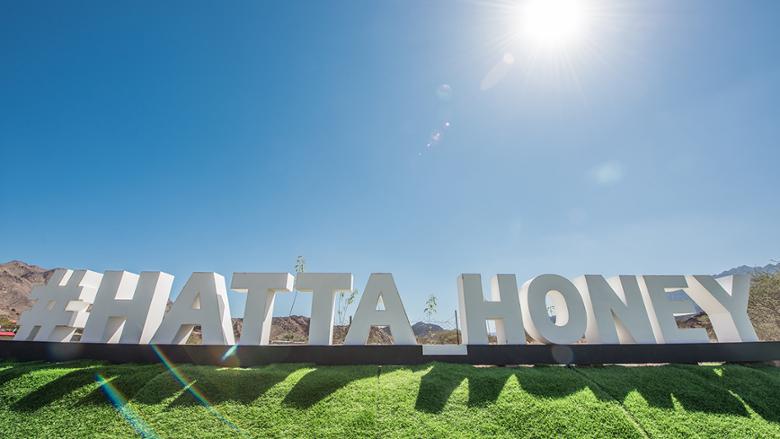
Driving through the long winding roads, hardly spotting any vehicles or signs of human activity, it is past 10.30am when we enter Hatta, the inland exclave of Dubai, where the sweeping views of the Hajar mountains continue to hold us in sway. Once known as a city of citadels and forts, Hatta is now transforming itself into a tourist hotspot. We spot a giant ‘Hatta’ sign, placed around 450m high in the Hajar Mountains, reminiscent of the ‘Hollywood’ sign on the outskirts of Los Angeles.
Just a couple of kilometres ahead and smiling honey bee board signs direct us to the Hatta Honey Bee Garden. The last 600m stretch is an uneven gravel track with descending slopes that twist and turn, and we soon spot numerous multi-colour painted wooden hives indicating that we have arrived at our destination.
We are greeted by Cheremie Royo Cenas, the guide at the centre, who ushers us into a large hall where hexagonal honeycomb-inspired design fixtures dominate the interior.
Opened to visitors since late December 2018, the bee farm tour offers an unparalleled experience of witnessing live the intricacies and activities of the bee world, says Cheremie. ‘Sometimes you even get to see the larva coming out of the eggs.’
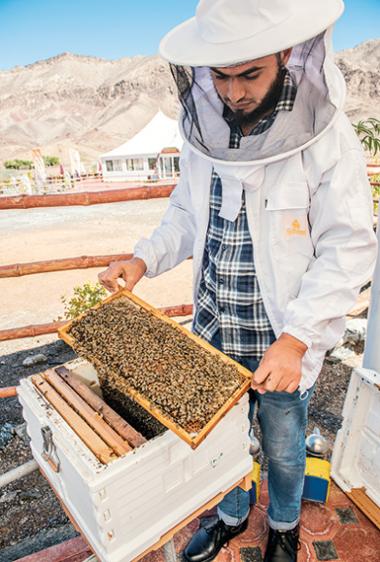
We watch a short video summarising the honey production process at the Hatta Honey factory and we are then helped into our ventilated protective gear before we follow Mustafa Mohammed Mustafa, a professional beekeeper, into the apiary.
‘This facility is the Middle East’s first queen bee rearing station and is a highly advanced apiary and bee rearing centre,’ he informs. ‘It is equipped with 800 beehives and has the capacity to breed up to 100,000 queen bees annually.’
Hatta Honey also has the unique distinction of being the first centre in the world to rear the ‘Saskatraz’ queen bee outside of Canada and North America, he adds. ‘Characterised by a shiny golden sheen, what makes ‘Saskatraz’ bees special is their ability to produce large amounts of honey. They are also a calm and gentle breed and show a strong resistance to parasites and diseases.’
Before we head to the hives, Mustafa leads us to the three varieties of trees on whose flowers the bees feed on to produce honey. ‘The UAE’s national tree, Al Ghaf,’ he says, ‘is the most drought tolerant and has the ability to withstand high temperatures. It blooms for 30 to 35 days during June and July and bees use the nectar from the tree’s flowers to produce honey that has long been considered a delicacy across the country.’
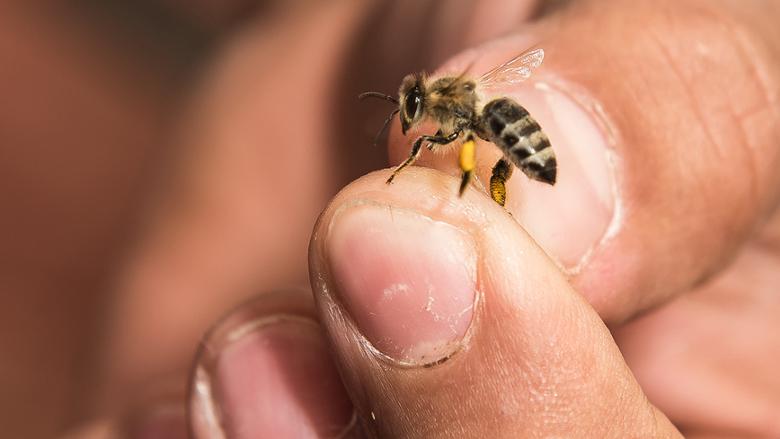
Samar honey, which has a golden shade, is culled from the thorny Samar that only blooms for a month or so from April to May, occasionally extending to June. ‘Samar flourishes in rocky mountain areas like Hatta and it has a highly aromatic white flower. The honey produced has a distinct flavour and is well known for its range of medicinal properties.
‘The Sidr tree is an evergreen tree whose flowers called the Yibyab produce a high-value honey. The flowers bloom from September to November and its honey is famed for its exquisite taste. Its leaves are used as herbal shampoo while the wood ash is used to treat certain snakebites.’
We are then led to a display showcasing the different types of hives, both old and modern. These include wooden hives, clay pot hives, hives made from date palm tree trunks, skeps or specially designed domed baskets, polystyrene beehives, and natural beehives which are commonly found in the mountains.
The beehives used at Hatta Honey are made in Turkey and has a layer of foam that regulates the temperature inside and is specially designed for extreme weather conditions. It also aids in pollen collection and helps prevent moisture build-up inside the beehive, adds Mustafa. ‘Since it is made of plastic, it is easy to clean and transport — relocation is required during the Sidr flowering season as these trees are abundant in Abu Dhabi too.’
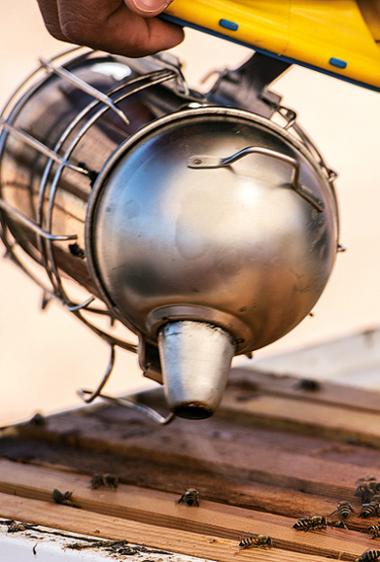
Before he opens the beehive, Mustafa wafts smoke over it with a metal smoker. This procedure, he explains, is a simple way of calming the bees. ‘They go into relaxation mode and are therefore less likely to sting.’
Slowly and carefully, Mustafa removes one of the wooden frames from the hive — there are 10 in each hive. We get our first look at a perfectly created honeycomb, which is the very heart of the beehive. Each hexagonal cell is built from wax secreted by the bees, explains Mustafa.
We notice that some cells are cream-coloured and the rest are a darker shade of brown. ‘The cream cells are laden with honey,’ he explains, and as he squeezes them gently, the thin, golden nectar oozes out of the capped cells. ‘The brown cells contain the eggs that are laid by the queen bee,’ he adds, showing us the tiny larvae in the cells.
Each hive has tiny openings at the base that allow the bees to forage for nectar on flowers within a one-and-a-half kilometre radius. During the flowering season, around 50,000 bees could be found in a single hive, while the number drops down to 20,000 to 30,000 during the off-season periods.
Pointing to the largest bee on the honeycomb, he explains that this is the queen bee, the mother of all worker bees and drones. ‘She lives for two to five years and lays a whopping 1,500 eggs per day.’
We are surprised to hear that the queen mates only once in her lifetime with 15 to 20 drones — male of the species. The drones die after mating but for the queen, her hard work is just beginning. ‘The survival of a colony rests on the queen’s ability to lay eggs and increase its population,’ says Mustafa. ‘A drone has no stingers nor can they collect pollen or nectar. A drone is the product of an unfertilised egg. They live for about 90 days and their only job is to mate the queen.’

There are about 3,000 male bees in a busy colony, but it is the female worker bees that outnumber them and do all the work in the beehive. Numbering around 60,000 per colony, they collect flower nectar which is stored inside the honeycomb. ‘The constant fanning of the bees’ wings — which also causes the ‘buzz’ — causes evaporation creating the sweet liquid,’ he explains. ‘Honey is stored as food and it provides the energy for the bees and helps heat the hive during winter. However, as bees make more honey than the colony needs, we can harvest the excess and bottle it for our use.’
The role of a honey bee is not solely about making honey, he adds, asking us to observe the bees that are coming back to the hive after gathering nectar. ‘When bees flit from flower to flower, they spread pollen as they go. This vital task of pollination is why they are so important to our ecosystem, especially considering the fact that they are responsible for one in every three bites of food that we have on our plate.”
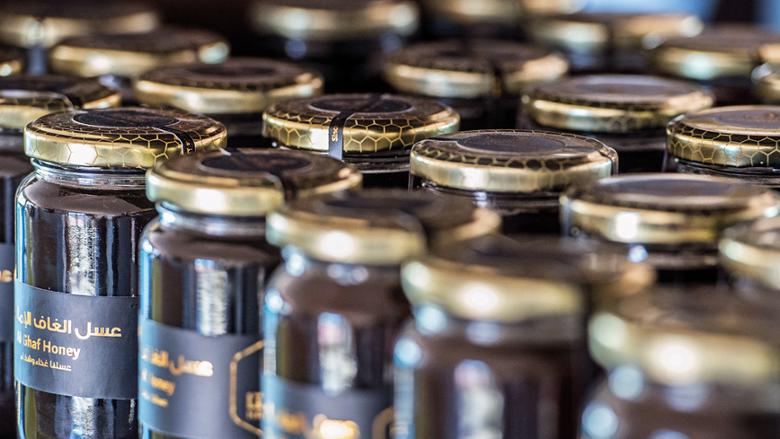
Mustafa then proceeds to show us the manual honey extractor — a large cylindrical jar — which has a small spigot at the base to collect the honey. This is then filtered and bottled and ready for use.
Back at the centre, we browse around the array of cosmetics and soaps containing Hatta honey and pick up a few beeswax candles. Before we choose from among the three varieties of honey produced here, we enjoy a tasting session, and needless to say, it is the lush Sidr, with its layers of rich flavour that we are eager to enjoy more.
Lessons to learn from bees
With its high mountains, fertile plains, valleys and fresh dams, Hatta is currently home to around 50 honey producers. ‘The weather here is ideal for the rearing of our specialty ‘Saskatraz’ queen bees,’ says Manea Ahmad Al Kaabi, master beekeeper and General Director of Hatta Honey.
Al Kaabi grew up in the mountains of Hatta and comes from a long line of beekeepers. ‘As a child, I would see natural hives in the wild, and have personally witnessed the change from the traditional ways of beekeeping in the region when hives were fashioned from the cut-out sections of palm trees.

‘As new methods and techniques evolved, beekeepers also had to adapt to keep their hives healthy. Soon people would come to see the hives, the bees and to spot the queen, and we realised there was genuine interest in understanding the techniques of honey production and beekeeping. That is how the idea of setting up the Hatta Honey Bee Garden came about.’
The Garden is now open to students and tourists to educate them about the methods of scientific queen beekeeping. ‘Plans are also afoot to offer an intensive training course for those interested in bee keeping,’ he adds. ‘Customers will also be given the opportunity to adopt bee hives and produce their own honey.’
Even after spending an entire lifetime in beekeeping, what continues to fascinate Al Kaabi is the "ability of the bees in a colony to work as a team. They are very organised and systematic, can adapt to whatever environment they are in, and work towards one common goal with no conflict of interest. That is something, we as humans, ought to emulate from these tiny industrious creatures.’
To book a tour at the Hatta Honey Bee Garden, call 056 499 6405. Or visit hattahoney.ae











